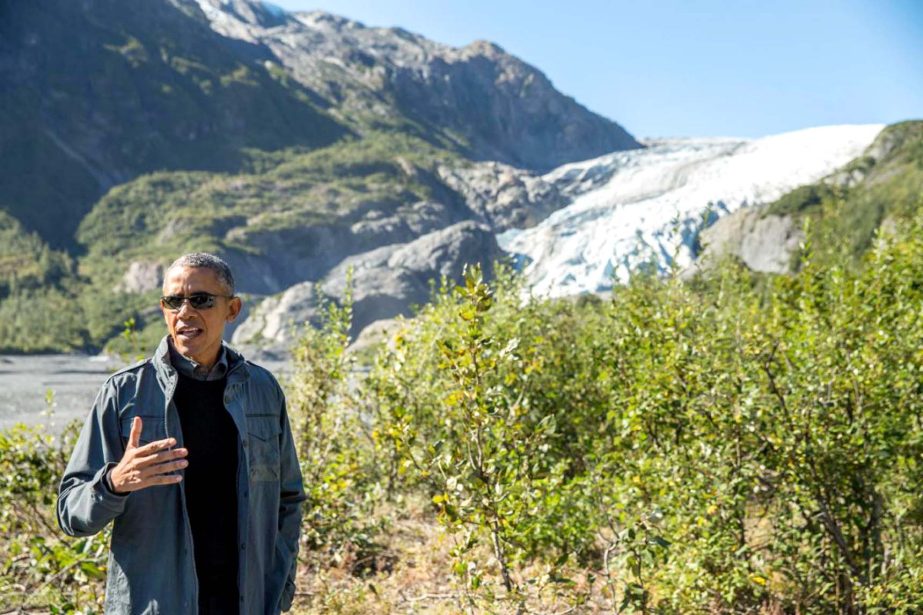
Reuters, Seward :
President Barack Obama walked down a winding wooded path past a small brown post marked “1926,” past a glacial stream trickling over gravel that eons of ice have scraped off mountain peaks.
He reached another post reading “1951” – a marker for the edge of Alaska’s Exit Glacier that year – and gazed up toward where the rock-rutted ice mass has since receded, a quarter-mile away.
“This is as good a signpost of what we’re dealing with on climate change as just about anything,” Obama told the reporters waiting on the outwash plain at the base of the glacier.
It was the signature moment of Obama’s trek to Alaska, aimed at making the world pay heed to how much damage rising seas have already caused, and demand their leaders reach a deal in Paris in December to curb climate-changing carbon emissions.
Last year alone, the Exit glacier melted and retreated 187 feet toward the Harding ice field, which itself has lost 10 percent of its mass since 1950, mainly due to climate change.
“It’s spectacular,” Obama said, casting a glance over his shoulder and pausing, as the cameras clicked.
“We want to make sure that our own grandkids can see this,” he said.
It’s a message Obama will continue to send leading up to the U.N. summit in Paris, which will itself be a marker for his record on addressing what he has called the most pressing issue of his time.
After his hike, he planned to board a Coast Guard cutter to see coastline erosion caused by rising seas. On Wednesday, he will visit two remote coastal communities where residents are changing their traditional ways of life to adapt to climate change.
President Barack Obama walked down a winding wooded path past a small brown post marked “1926,” past a glacial stream trickling over gravel that eons of ice have scraped off mountain peaks.
He reached another post reading “1951” – a marker for the edge of Alaska’s Exit Glacier that year – and gazed up toward where the rock-rutted ice mass has since receded, a quarter-mile away.
“This is as good a signpost of what we’re dealing with on climate change as just about anything,” Obama told the reporters waiting on the outwash plain at the base of the glacier.
It was the signature moment of Obama’s trek to Alaska, aimed at making the world pay heed to how much damage rising seas have already caused, and demand their leaders reach a deal in Paris in December to curb climate-changing carbon emissions.
Last year alone, the Exit glacier melted and retreated 187 feet toward the Harding ice field, which itself has lost 10 percent of its mass since 1950, mainly due to climate change.
“It’s spectacular,” Obama said, casting a glance over his shoulder and pausing, as the cameras clicked.
“We want to make sure that our own grandkids can see this,” he said.
It’s a message Obama will continue to send leading up to the U.N. summit in Paris, which will itself be a marker for his record on addressing what he has called the most pressing issue of his time.
After his hike, he planned to board a Coast Guard cutter to see coastline erosion caused by rising seas. On Wednesday, he will visit two remote coastal communities where residents are changing their traditional ways of life to adapt to climate change.

